Near-Infrared Artificial Optical Synapse Based on the P(VDF-TrFE)-Coated InAs Nanowire Field-Effect Transistor
Abstract
1. Introduction
2. Materials and Methods
2.1. Nanowire Growth and Device Fabrication
2.2. Characterization and Measurement
3. Results and Discussion
3.1. The Pristine InAs NW Device Optoelectronic Properties
3.2. The P(VDF-TrFE)-Coated InAs NW Device Optoelectronic Properties
3.3. Optical Synaptic Behavior Based on P(VDF-TrFE)-Coated InAs NW FET
4. Conclusions
Author Contributions
Funding
Institutional Review Board Statement
Informed Consent Statement
Data Availability Statement
Acknowledgments
Conflicts of Interest
References
- Merolla, P.A.; Arthur, J.V.; Alvarez-Icaza, R.; Cassidy, A.S.; Sawada, J.; Akopyan, F.; Jackson, B.L.; Imam, N.; Guo, C.; Nakamura, Y.; et al. A million spiking-neuron integrated circuit with a scalable communication network and interface. Science 2014, 345, 668–673. [Google Scholar] [CrossRef] [PubMed]
- Hahnloser, R.H.R.; Sarpeshkar, R.; Mahowald, M.A.; Douglas, R.J.; Seung, H.S. Digital selection and analogue amplification coexist in a cortex-inspired silicon circuit. Nature 2000, 405, 947–951. [Google Scholar] [CrossRef] [PubMed]
- Markovic, D.; Mizrahi, A.; Querlioz, D.; Grollier, J. Physics for neuromorphic computing. Nat. Rev. Phys. 2020, 2, 499–510. [Google Scholar] [CrossRef]
- Feldmann, J.; Youngblood, N.; Wright, C.D.; Bhaskaran, H.; Pernice, W.H.P. All-optical spiking neurosynaptic networks with self-learning capabilities. Nature 2019, 569, 208–214. [Google Scholar] [CrossRef]
- Tan, C.L.; Mohseni, H. Emerging technologies for high performance infrared detectors. Nanophotonics 2018, 7, 169–197. [Google Scholar] [CrossRef]
- Benyahia, K.; Djeffal, F.; Ferhati, H.; Bendjerad, A.; Benhaya, A.; Saidi, A. Self-powered photodetector with improved and broadband multispectral photoresponsivity based on ZnO-ZnS composite. J. Alloy. Compd. 2021, 859, 158242. [Google Scholar] [CrossRef]
- Farah, S.E.; Ferhati, H.; Dibi, Z.; Djeffal, F. Performance analysis of broadband Mid-IR graphene-phototransistor using strained black phosphorus sensing gate: DFT-NEGF investigation. Micro Nanostruct. 2022, 163, 107187. [Google Scholar] [CrossRef]
- Shastri, B.J.; Tait, A.N.; de Lima, T.F.; Pernice, W.H.P.; Bhaskaran, H.; Wright, C.D.; Prucnal, P.R. Photonics for artificial intelligence and neuromorphic computing. Nat. Photonics 2021, 15, 102–114. [Google Scholar] [CrossRef]
- Ilyas, N.; Wang, J.; Li, C.; Li, D.; Fu, H.; Gu, D.; Jiang, X.; Liu, F.; Jiang, Y.; Li, W. Nanostructured materials and architectures for advanced optoelectronic synaptic devices. Adv. Funct. Mater. 2022, 32, 2110976. [Google Scholar] [CrossRef]
- Yu, J.J.; Liang, L.Y.; Hu, L.X.; Duan, H.X.; Wu, W.H.; Zhang, H.L.; Gao, J.H.; Zhuge, F.; Chang, T.C.; Cao, H.T. Optoelectronic neuromorphic thin-film transistors capable of selective attention and with ultra-low power dissipation. Nano Energy 2019, 62, 772–780. [Google Scholar] [CrossRef]
- Wang, J.; Chen, Y.; Kong, L.-A.; Fu, Y.; Gao, Y.; Sun, J. Deep-ultraviolet-triggered neuromorphic functions in In-Zn-O phototransistors. Appl. Phys. Lett. 2018, 113, 151101. [Google Scholar] [CrossRef]
- Wuttig, M.; Yamada, N. Phase-change materials for rewriteable data storage. Nat. Mater. 2007, 6, 824–832. [Google Scholar] [CrossRef] [PubMed]
- Ielmini, D.; Lacaita, A.L. Phase change materials in non-volatile storage. Mater. Today 2011, 14, 600–607. [Google Scholar] [CrossRef]
- Jo, S.H.; Chang, T.; Ebong, I.; Bhadviya, B.B.; Mazumder, P.; Lu, W. Nanoscale memristor device as synapse in neuromorphic systems. Nano Lett. 2010, 10, 1297–1301. [Google Scholar] [CrossRef] [PubMed]
- Chen, S.; Mahmoodi, M.R.; Shi, Y.; Mahata, C.; Yuan, B.; Liang, X.; Wen, C.; Hui, F.; Akinwande, D.; Strukov, D.B.; et al. Wafer-scale integration of two-dimensional materials in high-density memristive crossbar arrays for artificial neural networks. Nat. Electron. 2020, 3, 638–645. [Google Scholar] [CrossRef]
- Kim, M.-K.; Lee, J.-S. Synergistic improvement of long-term plasticity in photonic synapses using ferroelectric polarization in hafnia-based oxide-semiconductor transistors. Adv. Mater. 2020, 32, 1907826. [Google Scholar] [CrossRef]
- Li, X.; Li, S.; Tang, B.; Liao, J.; Chen, Q. A Vis-SWIR photonic synapse with low power consumption based on WSe2/In2Se3 ferroelectric heterostructure. Adv. Electron. Mater. 2022, 8, 2200343. [Google Scholar] [CrossRef]
- Xue, F.; He, X.; Liu, W.; Periyanagounder, D.; Zhang, C.; Chen, M.; Lin, C.-H.; Luo, L.; Yengel, E.; Tung, V.; et al. Optoelectronic ferroelectric domain-wall memories made from a single van Der Waals ferroelectric. Adv. Funct. Mater. 2020, 30, 2004206. [Google Scholar] [CrossRef]
- Wang, H.; Zhao, Q.; Ni, Z.; Li, Q.; Liu, H.; Yang, Y.; Wang, L.; Ran, Y.; Guo, Y.; Hu, W.; et al. A ferroelectric/electrochemical modulated organic synapse for ultraflexible, artificial visual-perception system. Adv. Mater. 2018, 30, 1803961. [Google Scholar] [CrossRef]
- Kumar, M.; Abbas, S.; Kim, J. All-oxide-based highly transparent photonic synapse for neuromorphic computing. ACS Appl. Mater. Interfaces 2018, 10, 34370–34376. [Google Scholar] [CrossRef]
- Li, B.; Wei, W.; Yan, X.; Zhang, X.; Liu, P.; Luo, Y.; Zheng, J.; Lu, Q.; Lin, Q.; Ren, X. Mimicking synaptic functionality with an InAs nanowire phototransistor. Nanotechnology 2018, 29, 34370–34376. [Google Scholar] [CrossRef] [PubMed]
- Ungureanu, M.; Zazpe, R.; Golmar, F.; Stoliar, P.; Llopis, R.; Casanova, F.; Hueso, L.E. A light-controlled resistive switching memory. Adv. Mater. 2012, 24, 2496–2500. [Google Scholar] [CrossRef] [PubMed]
- Wang, Y.; Yang, J.; Ye, W.; She, D.; Chen, J.; Lv, Z.; Roy, V.A.L.; Li, H.; Zhou, K.; Yang, Q.; et al. Near-infrared-irradiation-mediated synaptic behavior from tunable charge-trapping dynamics. Adv. Electron. Mater. 2020, 6, 1900765. [Google Scholar] [CrossRef]
- Tian, H.; Zhao, L.; Wang, X.; Yeh, Y.-W.; Yao, N.; Rand, B.P.; Ren, T.-L. Extremely low operating current resistive memory based on exfoliated 2D perovskite single crystals for neuromorphic computing. ACS Nano 2017, 11, 12247–12256. [Google Scholar] [CrossRef] [PubMed]
- Li, X.; Yu, B.; Wang, B.; Bi, R.; Li, H.; Tu, K.; Chen, G.; Li, Z.; Huang, R.; Li, M. Complementary photo-synapses based on light-stimulated porphyrin-coated silicon nanowires field-effect transistors (LPSNFET). Small 2021, 17, 2101434. [Google Scholar] [CrossRef]
- Shen, C.; Gao, X.; Chen, C.; Ren, S.; Xu, J.-L.; Xia, Y.-D.; Wang, S.-D. ZnO nanowire optoelectronic synapse for neuromorphic computing. Nanotechnology 2022, 33, 65205. [Google Scholar] [CrossRef]
- Yin, L.; Han, C.; Zhang, Q.; Ni, Z.; Zhao, S.; Wang, K.; Li, D.; Xu, M.; Wu, H.; Pi, X.; et al. Synaptic silicon-nanocrystal phototransistors for neuromorphic computing. Nano Energy 2019, 63, 103859. [Google Scholar] [CrossRef]
- Tan, H.; Ni, Z.; Peng, W.; Du, S.; Liu, X.; Zhao, S.; Li, W.; Ye, Z.; Xu, M.; Xu, Y.; et al. Broadband optoelectronic synaptic devices based on silicon nanocrystals for neuromorphic computing. Nano Energy 2018, 52, 422–430. [Google Scholar] [CrossRef]
- Yang, Y.; He, Y.L.; Nie, S.; Shi, Y.; Wan, Q. Light stimulated IGZO-based electric-double-layer transistors for photoelectric neuromorphic devices. IEEE Electron Device Lett. 2018, 39, 897–900. [Google Scholar] [CrossRef]
- Zhang, H.-S.; Dong, X.-M.; Zhang, Z.-C.; Zhang, Z.-P.; Ban, C.-Y.; Zhou, Z.; Song, C.; Yan, S.-Q.; Xin, Q.; Liu, J.-Q.; et al. Co-assembled perylene/graphene oxide photosensitive heterobilayer for efficient neuromorphics. Nat. Commun. 2022, 13, 4996. [Google Scholar] [CrossRef]
- Qin, S.; Wang, F.; Liu, Y.; Wan, Q.; Wang, X.; Xu, Y.; Shi, Y.; Wang, X.; Zhang, R. A light-stimulated synaptic device based on graphene hybrid phototransistor. 2D Mater. 2017, 4, 35022. [Google Scholar] [CrossRef]
- Seo, S.; Jo, S.H.; Kim, S.; Shim, J.; Oh, S.; Kim, J.H.; Heo, K.; Choi, J.W.; Choi, C.; Oh, S.; et al. Artificial optic-neural synapse for colored and color-mixed pattern recognition. Nat. Commun. 2018, 9, 5106. [Google Scholar] [CrossRef] [PubMed]
- Jiang, J.; Hu, W.; Xie, D.; Yang, J.; He, J.; Gao, Y.; Wan, Q. 2D electric-double-layer phototransistor for photoelectronic and spatiotemporal hybrid neuromorphic integration. Nanoscale 2019, 11, 1360–1369. [Google Scholar] [CrossRef] [PubMed]
- Zhou, J.; Li, H.; Tian, M.; Chen, A.; Chen, L.; Pu, D.; Hu, J.; Cao, J.; Li, L.; Xu, X.; et al. Multi-stimuli-responsive synapse based on vertical van der Waals heterostructures. ACS Appl. Mater. Interfaces 2022, 14, 35917–35926. [Google Scholar] [CrossRef] [PubMed]
- Liu, L.; Cheng, Z.; Jiang, B.; Liu, Y.; Zhang, Y.; Yang, F.; Wang, J.; Yu, X.-F.; Chu, P.K.; Ye, C. Optoelectronic artificial synapses based on two-dimensional transitional-metal trichalcogenide. ACS Appl. Mater. Interfaces 2021, 13, 30797–30805. [Google Scholar] [CrossRef]
- Maier, P.; Hartmann, F.; Emmerling, M.; Schneider, C.; Kamp, M.; Hoefling, S.; Worschech, L. Electro-photo-sensitive memristor for neuromorphic and arithmetic computing. Phys. Rev. Appl. 2016, 5, 54011. [Google Scholar] [CrossRef]
- Sun, Y.L.; Qian, L.; Xie, D.; Lin, Y.X.; Sun, M.X.; Li, W.W.; Ding, L.M.; Ren, T.L.; Palacios, T. Photoelectric synaptic plasticity realized by 2D perovskite. Adv. Funct. Mater. 2019, 29, 1902538. [Google Scholar] [CrossRef]
- Huang, X.; Li, Q.; Shi, W.; Liu, K.; Zhang, Y.; Liu, Y.; Wei, X.; Zhao, Z.; Guo, Y.; Liu, Y. Dual-mode learning of ambipolar synaptic phototransistor based on 2D perovskite/organic heterojunction for flexible color recognizable visual system. Small 2021, 17, 2102820. [Google Scholar] [CrossRef]
- Sha, X.; Cao, Y.; Meng, L.; Yao, Z.; Gao, Y.; Zhou, N.; Zhang, Y.; Chu, P.K.; Li, J. Near-infrared photonic artificial synapses based on organic heterojunction phototransistors. Appl. Phys. Lett. 2022, 120, 151103. [Google Scholar] [CrossRef]
- Ni, Y.; Feng, J.; Liu, J.; Yu, H.; Wei, H.; Du, Y.; Liu, L.; Sun, L.; Zhou, J.; Xu, W. An artificial nerve capable of UV-perception, NIR-Vis switchable plasticity modulation, and motion state monitoring. Adv. Sci. 2022, 9, 2102036. [Google Scholar] [CrossRef]
- Mu, B.; Guo, L.; Liao, J.; Xie, P.; Ding, G.; Lv, Z.; Zhou, Y.; Han, S.-T.; Yan, Y. Near-infrared artificial synapses for artificial sensory neuron system. Small 2021, 17, 2103837. [Google Scholar] [CrossRef] [PubMed]
- Zucker, R.S.; Regehr, W.G. Short-term synaptic plasticity. Annu. Rev. Physiol. 2002, 64, 355–405. [Google Scholar] [CrossRef] [PubMed]
- Han, Y.; Fu, M.; Tang, Z.; Zheng, X.; Ji, X.; Wang, X.; Lin, W.; Yang, T.; Chen, Q. Switching from negative to positive photoconductivity toward intrinsic photoelectric response in InAs nanowire. ACS Appl. Mater. Interfaces 2017, 9, 2867–2874. [Google Scholar] [CrossRef] [PubMed]
- Wang, H.; Wang, F.; Xu, T.; Xia, H.; Xie, R.; Zhou, X.; Ge, X.; Liu, W.; Zhu, Y.; Sun, L.; et al. Slowing hot-electron relaxation in mix-phase nanowires for hot-carrier photovoltaics. Nano Lett. 2021, 21, 7761–7768. [Google Scholar] [CrossRef] [PubMed]
- Zha, C.; Yan, X.; Yuan, X.; Zhang, Y.; Zhang, X. An artificial optoelectronic synapse based on an InAs nanowire phototransistor with negative photoresponse. Opt. Quantum Electron. 2021, 53, 587. [Google Scholar] [CrossRef]
- Jiang, Y.; Shen, R.; Li, T.; Tian, J.; Li, S.; Tan, H.H.; Jagadish, C.; Chen, Q. Enhancing the electrical performance of InAs nanowire field-effect transistors by improving the surface and interface properties by coating with thermally oxidized Y2O3. Nanoscale 2022, 14, 12830–12840. [Google Scholar] [CrossRef]
- Wang, X.; Pan, D.; Sun, M.; Lyu, F.; Zhao, J.; Chen, Q. High-performance room-temperature UV-IR photodetector based on the InAs nanosheet and its wavelength- and intensity-dependent negative photoconductivity. ACS Appl. Mater. Interfaces 2021, 13, 26187–26195. [Google Scholar] [CrossRef]
- Takei, K.; Fang, H.; Kumar, S.B.; Kapadia, R.; Gao, Q.; Madsen, M.; Kim, H.S.; Liu, C.-H.; Chueh, Y.-L.; Plis, E.; et al. Quantum confinement effects in nanoscale-thickness InAs membranes. Nano Lett. 2011, 11, 5008–5012. [Google Scholar] [CrossRef]
- Wunnicke, O. Gate capacitance of back-gated nanowire field-effect transistors. Appl. Phys. Lett. 2006, 89, 83102. [Google Scholar] [CrossRef]
- Dayeh, S.A.; Aplin, D.P.R.; Zhou, X.; Yu, P.K.L.; Yu, E.T.; Wang, D. High electron mobility InAs nanowire field-effect transistors. Small 2007, 3, 326–332. [Google Scholar] [CrossRef]
- Ullah, A.R.; Joyce, H.J.; Tan, H.H.; Jagadish, C.; Micolich, A.P. The influence of atmosphere on the performance of pure-phase WZ and ZB InAs nanowire transistors. Nanotechnology 2017, 28, 454001. [Google Scholar] [CrossRef]
- Yadav, P.V.K.; Ajitha, B.; Reddy, Y.A.K.; Sreedhar, A. Recent advances in development of nanostructured photodetectors from ultraviolet to infrared region: A review. Chemosphere 2021, 279, 130473. [Google Scholar] [CrossRef]
- Li, Z.; Allen, J.; Allen, M.; Tan, H.H.; Jagadish, C.; Fu, L. Review on III–V semiconductor single nanowire-based room temperature infrared photodetectors. Materials 2020, 13, 1400. [Google Scholar] [CrossRef] [PubMed]
- Rai, S.C.; Wang, K.; Ding, Y.; Marmon, J.K.; Bhatt, M.; Zhang, Y.; Zhou, W.; Wang, Z.L. Piezo-phototronic effect enhanced UV/Visible photodetector based on fully wide band gap type-II ZnO/ZnS core/shell nanowire array. ACS Nano 2015, 9, 6419–6427. [Google Scholar] [CrossRef]
- Kind, H.; Yan, H.Q.; Messer, B.; Law, M.; Yang, P.D. Nanowire ultraviolet photodetectors and optical switches. Adv. Mater. 2002, 14, 158–160. [Google Scholar] [CrossRef]
- Shen, R.; Jiang, Y.F.; Li, X.; Tian, J.M.; Li, S.; Li, T.; Chen, Q. Artificial synapse based on an InAs nanowire field-effect transistor with ferroelectric polymer P(VDF-TrFE) passivation. ACS Appl. Electron. Mater 2022, 4, 5008–5016. [Google Scholar] [CrossRef]
- Dai, X.; Zhang, S.; Wang, Z.; Adamo, G.; Liu, H.; Huang, Y.; Couteau, C.; Soci, C. GaAs/AlGaAs nanowire photodetector. Nano Lett. 2014, 14, 2688–2693. [Google Scholar] [CrossRef]
- Jang, S.; Jang, S.; Lee, E.H.; Kang, M.J.; Wang, G.; Kim, T.W. Ultrathin conformable organic artificial synapse for wearable intelligent device applications. ACS Appl. Mater. Interfaces 2019, 11, 1071–1080. [Google Scholar] [CrossRef]
- Murre, J.M.J.; Dros, J. Replication and analysis of Ebbinghaus’ forgetting curve. PLoS ONE 2015, 10, e0120644. [Google Scholar] [CrossRef]
- McGaugh, J.L. Neuroscience-memory-a century of consolidation. Science 2000, 287, 248–251. [Google Scholar] [CrossRef]
- Shao, L.; Wang, H.L.; Yang, Y.; He, Y.L.; Tang, Y.C.; Fang, H.H.; Zhao, J.W.; Xiao, H.S.; Liang, K.; Wei, M.M.; et al. Optoelectronic properties of printed photogating carbon nanotube thin film transistors and their application for light-stimulated neuromorphic devices. ACS Appl. Mater. Interfaces 2019, 11, 12161–12169. [Google Scholar] [CrossRef] [PubMed]
- Li, H.; Jiang, X.; Ye, W.; Zhang, H.; Zhou, L.; Zhang, F.; She, D.; Zhou, Y.; Han, S.-T. Fully photon modulated heterostructure for neuromorphic computing. Nano Energy 2019, 65, 104000. [Google Scholar] [CrossRef]
- Shrivastava, S.; Lin, Y.-T.; Pattanayak, B.; Pratik, S.; Hsu, C.-C.; Kumar, D.; Lin, A.S.; Tseng, T.-Y. Zn2SnO4 thin film based nonvolatile positive optoelectronic memory for neuromorphic computing. ACS Appl. Electron. Mater. 2022, 4, 1784–1793. [Google Scholar] [CrossRef]
- Wang, Y.; Yang, J.; Wang, Z.; Chen, J.; Yang, Q.; Lv, Z.; Zhou, Y.; Zhai, Y.; Li, Z.; Han, S.-T. Near-infrared annihilation of conductive filaments in quasiplane MoSe2/Bi2Se3 nanosheets for mimicking heterosynaptic plasticity. Small 2019, 15, 1805431. [Google Scholar] [CrossRef] [PubMed]
- Lee, G.S.; Jeong, J.-S.; Yang, M.K.; Song, J.D.; Lee, Y.T.; Ju, H. Non-volatile memory behavior of interfacial InOx layer in InAs nanowire field-effect transistor for neuromorphic application. Appl. Surf. Sci 2021, 541, 148483. [Google Scholar] [CrossRef]
- He, L.; Li, E.; Yu, R.; Chen, H.; Zhang, G. Multistage photo-synaptic transistor based on the regulation of ferroelectric P(VDF-TrFE). Acta Photonica Sinica 2021, 50, 904002. [Google Scholar]
- Qi, L.; Ruan, S.C.; Zeng, Y.J. Review on recent developments in 2D ferroelectrics: Theories and applications. Adv. Mater. 2021, 33, 2005098. [Google Scholar] [CrossRef]
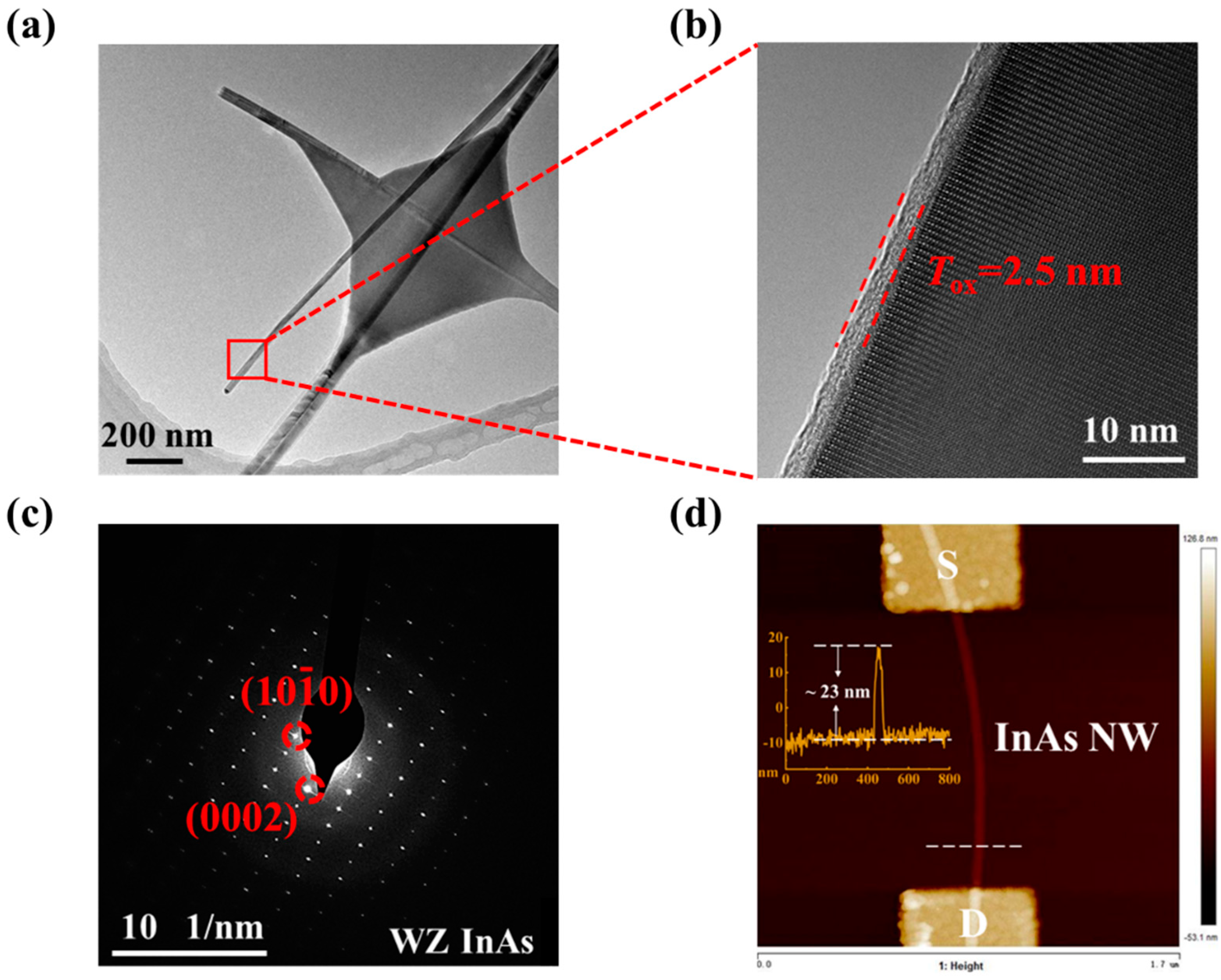

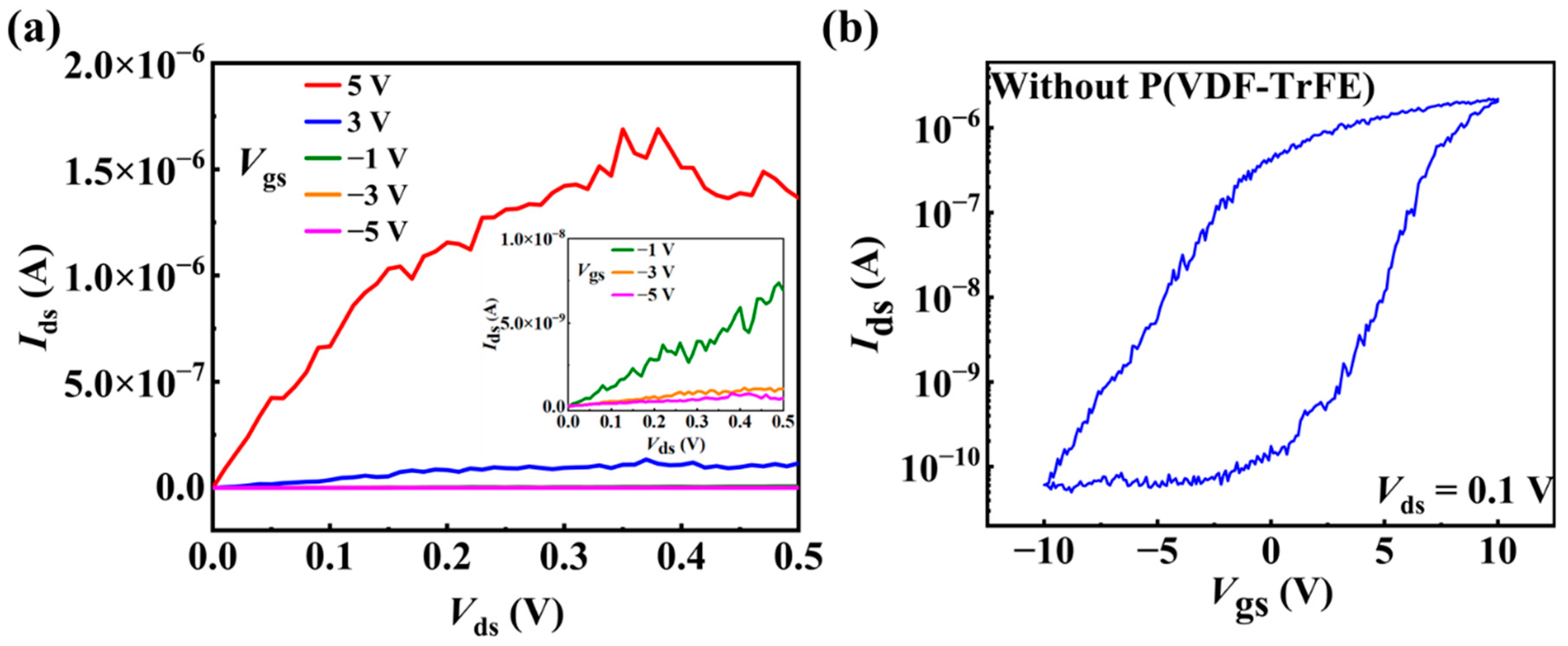

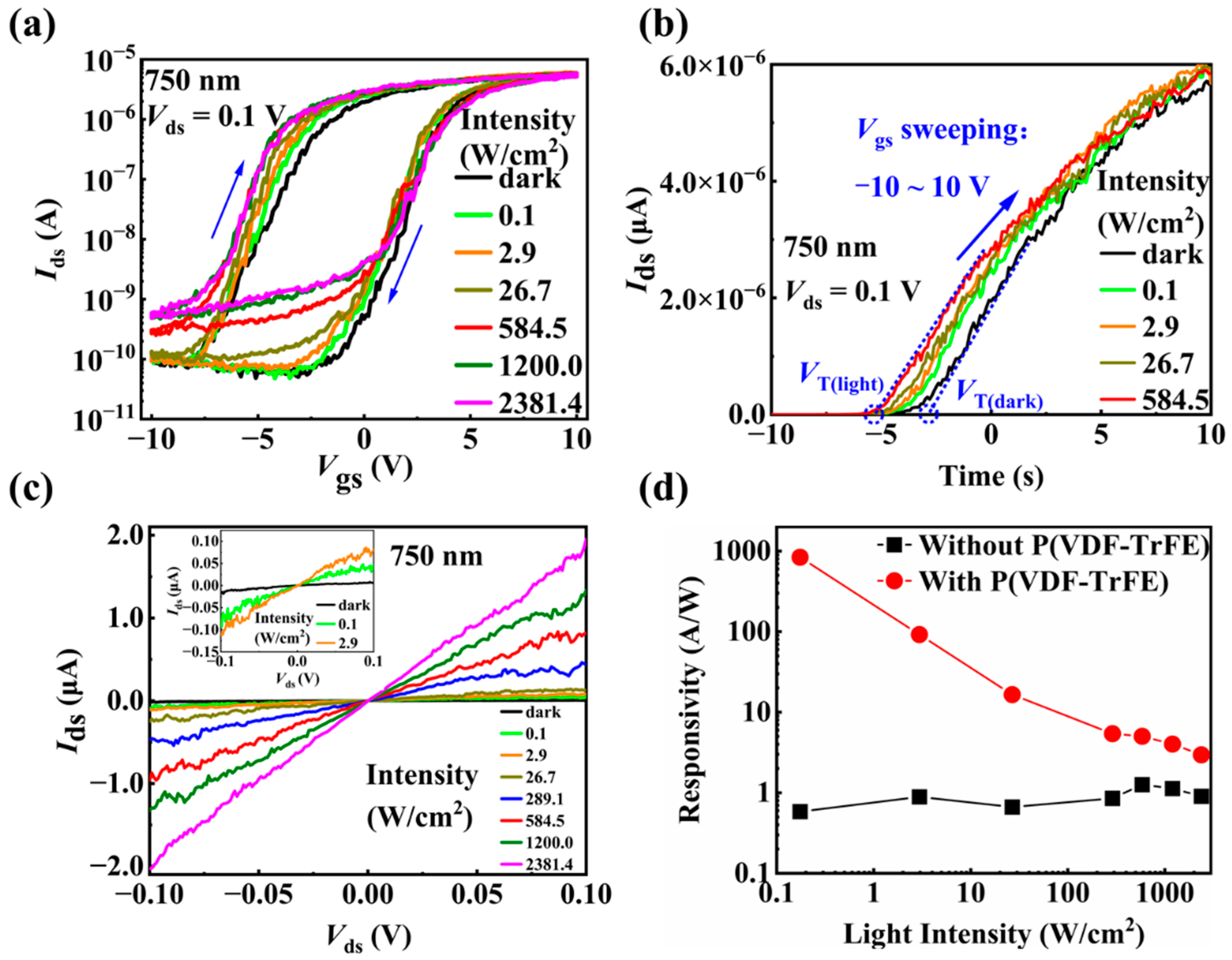
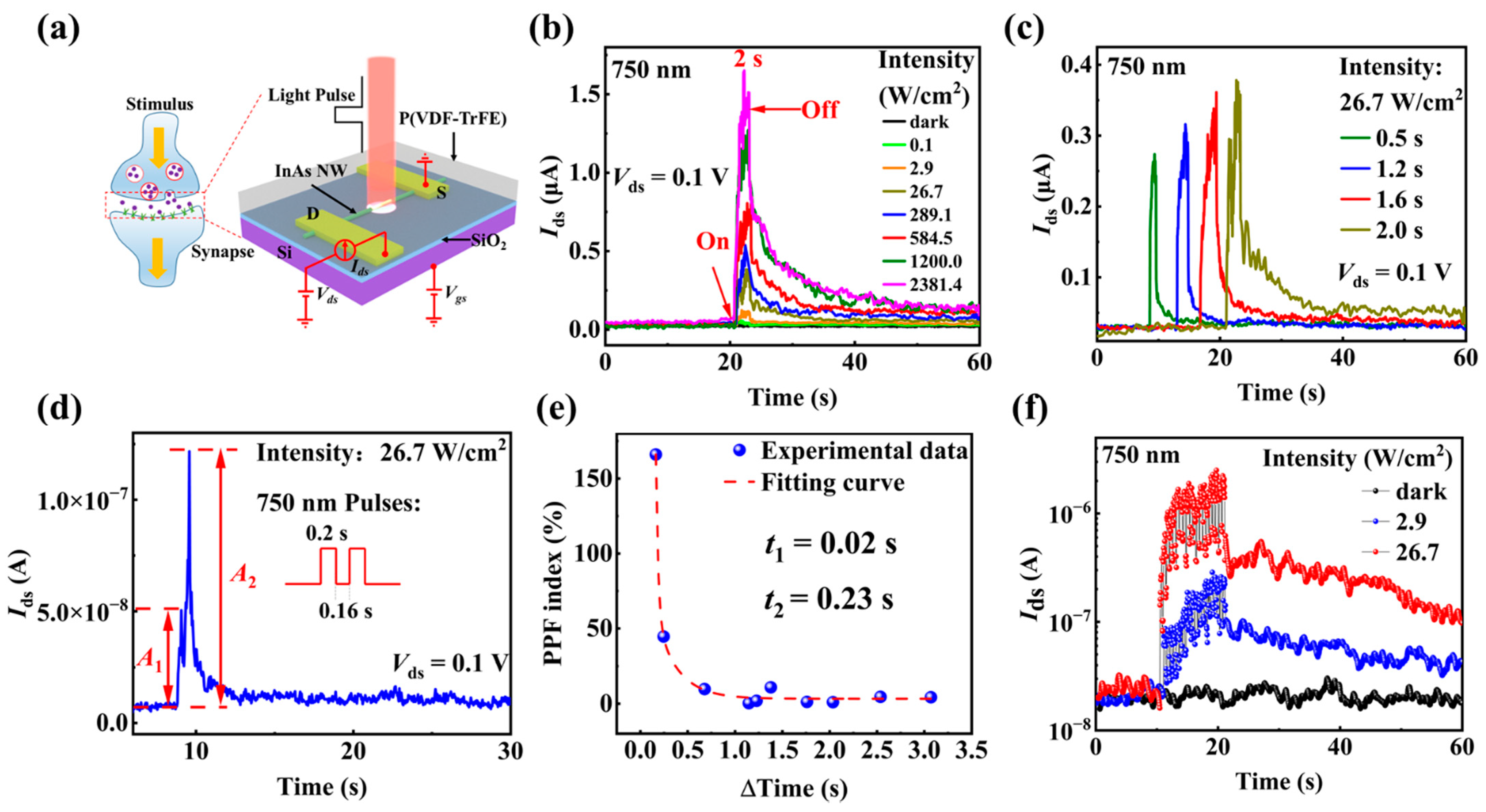


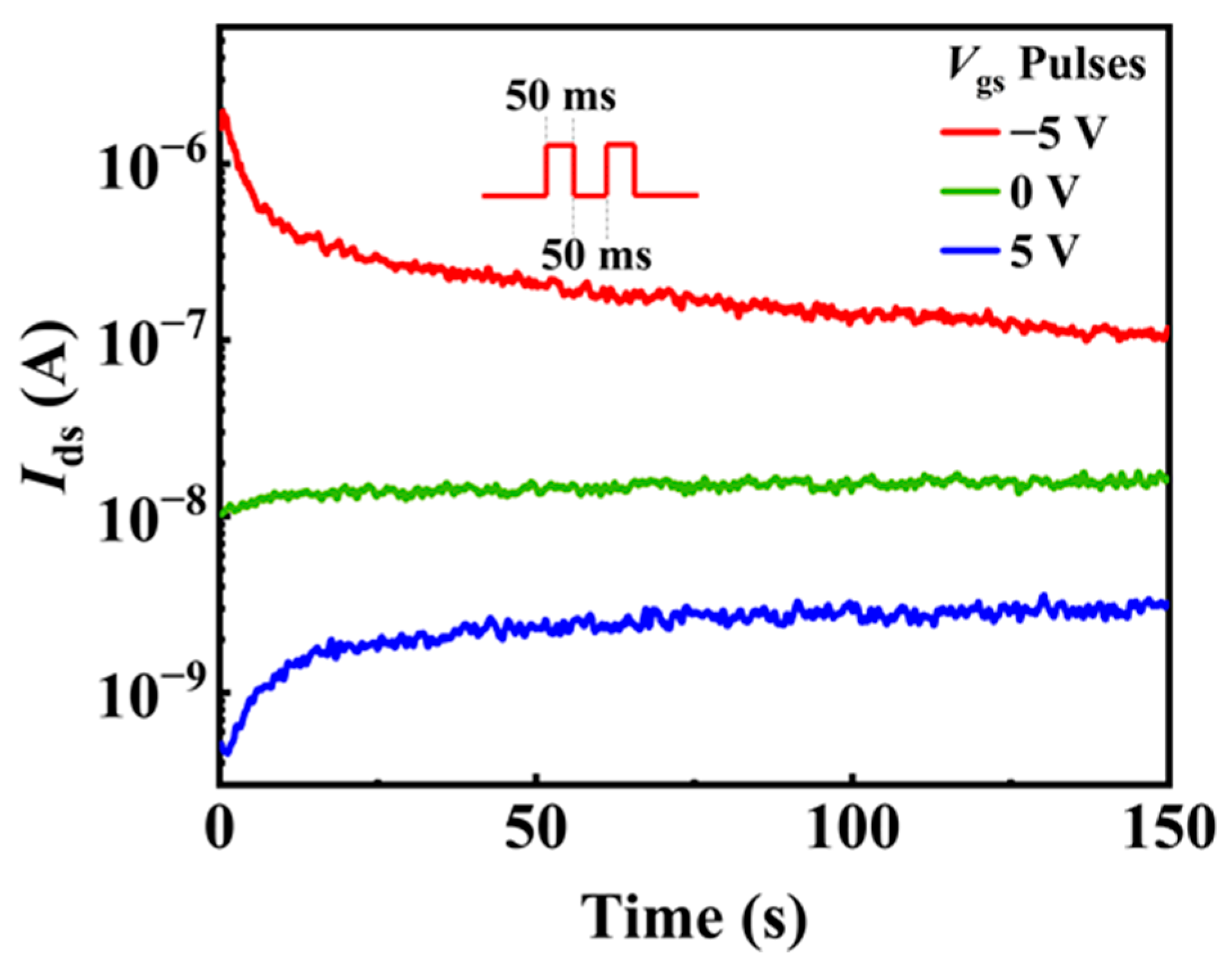
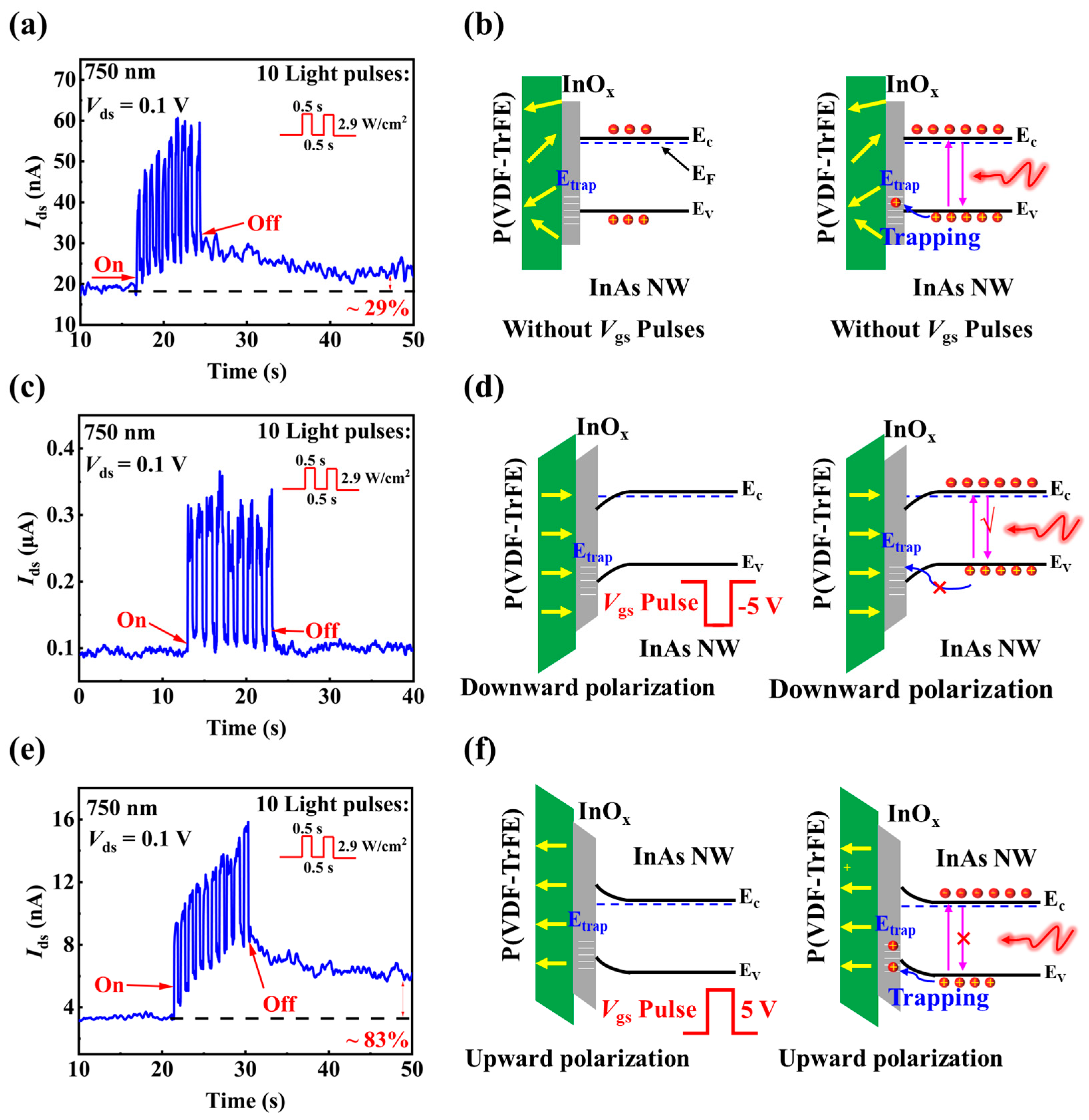
| Type | Active Materials | Vds (V) | Ion/Ioff Ratio | Response Wavelength (nm) | R (A/W) | Features * | PPF Index | Ref. |
|---|---|---|---|---|---|---|---|---|
| Organic | P(IID-BT) | −30 | 3 × 103 | 550, 850 | — | EPSC, PPF, STP/LTP | 200% | [19] |
| PEA2SnI4/Y6 | 40 | — | 300–1000 | 200 | EPSC/IPSC, PPF, STM/LTM | 160% | [38] | |
| PDPPBTT | −5 | ~103 | 808 | — | EPSC, PPF | ~155% | [39] | |
| C8-BTBT/F16CuPc | 0.2 | — | 380, 640, 790 | — | PSC, PPF/PPD, STP/LTP | 100% | [40] | |
| Pentacene | −30 | — | 790 | — | EPSC, PPF/PPD, STP/LTP | ~150% | [41] | |
| Inorganic | Si nanocrystals | 5 | — | 375–1342 | — | STP/STD, LTP/LTD, STDP | 190% | [27] |
| Si nanocrystals | 0.5 | — | 532, 1342, 1870 | — | EPSC, PPF, STP, STDP | 149% | [28] | |
| ZnO/PbS QDs | 0.1 | — | 980 | — | PSC, PPD/PPF, SRDP | 14% | [62] | |
| α-In2Se3 | 0.1 | — | 650–1800 | — | EPSC, PPF, STP/LTP | 128% | [17] | |
| α-In2Se3 | 0.3 | >104 | 900 | — | PPF, STP/LTP | — | [18] | |
| MoSe2/Bi2Se3/PMMA | −30 | — | 580–860 | — | PPF/PPD, STP, LTP | 33.1% | [23] | |
| MoSe2/Bi2Se3 nanosheets | 0.1 | — | 790 | — | EPSC/IPSC, PPF/PPD, STP/LTP | 33.7% | [64] | |
| ITO/Zn2SnO4/ITO | 0.1 | — | 400—800 | 0.52 × 10−6 | EPSC, PPF, LTP | 160% | [63] | |
| Graphene oxide | 1 | — | 365—1550 | 0.9 | EPSC, SIDP/SNDP, PPF, STP/LTP | 114% | [30] | |
| Titanium trisulfide (TiS3) | 0.2 | ~4 × 102 | 400–800 | — | STDP | — | [35] | |
| SWCNT | −0.5 | — | 520–1310 | — | EPSC, LTP | 200% | [61] | |
| InAs nanowire | 0.1 | 6 × 103 | 750–1550 | 839.3 | EPSC, PPF, STP/LTP | 160% | This work |
Publisher’s Note: MDPI stays neutral with regard to jurisdictional claims in published maps and institutional affiliations. |
© 2022 by the authors. Licensee MDPI, Basel, Switzerland. This article is an open access article distributed under the terms and conditions of the Creative Commons Attribution (CC BY) license (https://creativecommons.org/licenses/by/4.0/).
Share and Cite
Shen, R.; Jiang, Y.; Li, Z.; Tian, J.; Li, S.; Li, T.; Chen, Q. Near-Infrared Artificial Optical Synapse Based on the P(VDF-TrFE)-Coated InAs Nanowire Field-Effect Transistor. Materials 2022, 15, 8247. https://doi.org/10.3390/ma15228247
Shen R, Jiang Y, Li Z, Tian J, Li S, Li T, Chen Q. Near-Infrared Artificial Optical Synapse Based on the P(VDF-TrFE)-Coated InAs Nanowire Field-Effect Transistor. Materials. 2022; 15(22):8247. https://doi.org/10.3390/ma15228247
Chicago/Turabian StyleShen, Rui, Yifan Jiang, Zhiwei Li, Jiamin Tian, Shuo Li, Tong Li, and Qing Chen. 2022. "Near-Infrared Artificial Optical Synapse Based on the P(VDF-TrFE)-Coated InAs Nanowire Field-Effect Transistor" Materials 15, no. 22: 8247. https://doi.org/10.3390/ma15228247
APA StyleShen, R., Jiang, Y., Li, Z., Tian, J., Li, S., Li, T., & Chen, Q. (2022). Near-Infrared Artificial Optical Synapse Based on the P(VDF-TrFE)-Coated InAs Nanowire Field-Effect Transistor. Materials, 15(22), 8247. https://doi.org/10.3390/ma15228247







